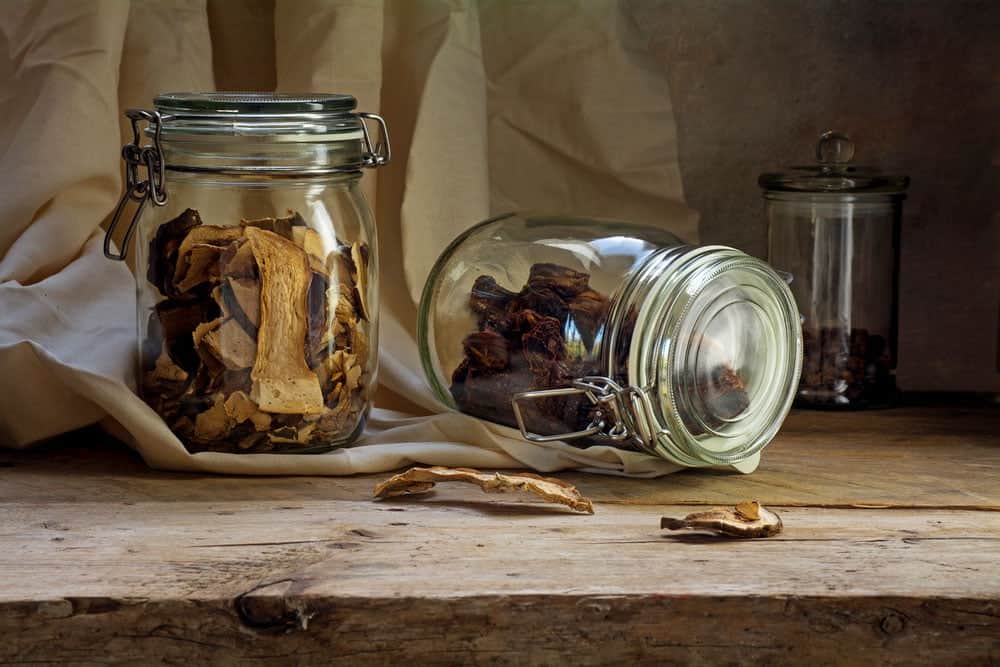Table of Contents
Whether you foraged an exciting haul of wild mushrooms or bought them from a store, proper storage is important. It preserves their freshness, quality, and taste!
Fresh mushrooms can last up to 2 weeks in the refrigerator when properly stored. If long-term storage is what you’re looking, there are options. You can freeze, dry, or pickle your mushrooms. This way you can enjoy them for many months to come!
Storing fresh Mushrooms
Fresh mushrooms have a short shelf life. For this reason, your best bet is to eat them as fresh as possible! If this isn’t an option, you can take some very simple steps to ensure they stay fresher for longer. Your best bet will be storing them in a refrigerator. Wild Mushrooms may need some extra processing first.
Storing Mushrooms in a Refrigerator
- Process and Clean Wild Mushrooms. Wild Mushrooms are often dirty and may need some processing. Scroll down to see our recommendations for processing wild mushrooms.
OR
Remove From Packaging. If they’re store-bought, remove them from plastic bags or plastic-wrapped containers. You want a breathable environment that will prevent condensation. - Place in a Paper Bag, Plate, or Bowl. These are all good options for storage. If you have a large number of mushrooms, make sure they are not in a deep bowl. This reduces breathability and may cause damage.
- Watch For Signs of Spoilage. Try to eat the mushrooms within a week! They may last for up to 2 weeks depending on their conditions.
Processing Wild Mushrooms for Storage
- Double Check. To begin, make sure you picked the right mushrooms! Sometimes it can be difficult in the field to get a proper ID. Especially if you’re not experienced! This is your chance to double-check.
- When in doubt, throw it out. Get rid of any old mushrooms that already have signs of decay. Check for maggots, insect damage, unpleasant odors. Remove anything that looks like it may be off.
- Wash your mushrooms. It’s recommended to use a moist towel or toothbrush to remove any dirt. A knife is also handy for scraping or cutting off unappealing parts of the mushroom. While you usually don’t want to wet mushrooms, this may not matter if you’re not eating them right away. You can wash them under the sink or even hose them down if you follow Step 4.
- Dry Them. I am NOT talking about dehydration. Just make sure they are not excessively wet or soggy. Sogginess reduces their shelf life, texture, and flavor. Dry them on cardboard or a breathable surface in the sun. If you need extra drying power, place a fan nearby to wind dry them. The ideal moisture level is when they are rubbery, soft, and have no signs of excessive moisture.
How do I know when Mushrooms have gone Bad?
- White fuzzy mold and other strange discoloration
- They become dark and squishy
- Have unpleasant odors
- Excessive sliminess
- Other changes that look unappetizing or give you any doubts
What happens if I eat spoiled Mushrooms?
In most cases, NOTHING. They probably won’t be enjoyable to eat and may cause an upset stomach. In the worst-case scenario, they may cause food poisoning. It is not recommended. When in doubt, throw it out!
Preserving Mushrooms for long term Storage
If you have more mushrooms than you can eat, preserving them for long-term storage is a great option.
Freezing cooked Mushrooms
This is by far the easiest method for long-term storage. Simply cook your mushrooms and freeze them for later. You can add salt, pepper, or whatever seasoning/ingredients you’d like to. Cooked and frozen mushrooms preserve indefinitely.
DO NOT freeze fresh mushrooms! They lose their texture and become slimy and mushy. They will no longer cook up well and may only be enjoyable blended into a soup or sauce.
Drying your Mushrooms
Another great option for long-term storage is drying your mushrooms. Some mushrooms may become more flavorful after drying. This is also your best option for medicinal mushrooms. This may be difficult in some climates without the proper set-up.
Using a Dehydrator. If you’re serious about mushrooms, you may consider purchasing a dehydrator. These can run anywhere from $40 to $200 depending on the brand. The best models will have temperature controls. Drying in the lowest temperature setting is the BEST for preserving flavors.
Air and Sun Drying. If your climate isn’t too wet and humid, you can dehydrate your mushrooms outside. Follow these tips for the best results.
- Cut them thin if they’re large mushrooms to increase their surface area. This significantly speeds drying.
- Place them above a breathable surface or on cardboard.
- Placing them in the sun not only speeds up the process, but it increases their vitamin D content.
- Facing a fan towards your mushrooms in a low setting will also help.
- Hanging them with string is another great option.
- As the mushrooms dry, they become lighter, so make sure they don’t get blown away in the wind!
- If sunlight isn’t available, or you’re not having good results, place them under a heat lamp!
Drying in the Oven. This is not the best method, but it works. They may lose flavor due to the high temperatures in the oven.
- Place your oven in a low setting and leave the door slightly open.
- Cut mushrooms into thin slices, 1″ thick.
- Place mushrooms in a large tray with plenty of room between them. Do NOT stack them!
- Flip the mushrooms around every 20-30 minutes.
- Wait for them to be crispy and store in closed containers.
How do I know when my Mushrooms are dry?
You want them to be crispy like a saltine cracker! If they’re soft and bendable, they still have moisture and will not store.
Store dry Mushrooms in airtight Containers!
Mushrooms can absorb humidity, so keep them in closed containers. Glass jars work great for this. For extra long-term storage, you can vacuum seal them. Additionally, place a desiccant (like those found in beef-jerky packages) to keep them dry. If your mushrooms absorb moisture, they may go bad!
Pickling your Mushrooms
Another simple strategy is making mushroom quick pickles! Cook your mushrooms and submerge them in vinegar inside a jar. Add salt and spices to taste. I recommend rosemary, pepper, garlic, dill, and other herbs. If you want something exotic, add curry powder! Store in the fridge for best results.

